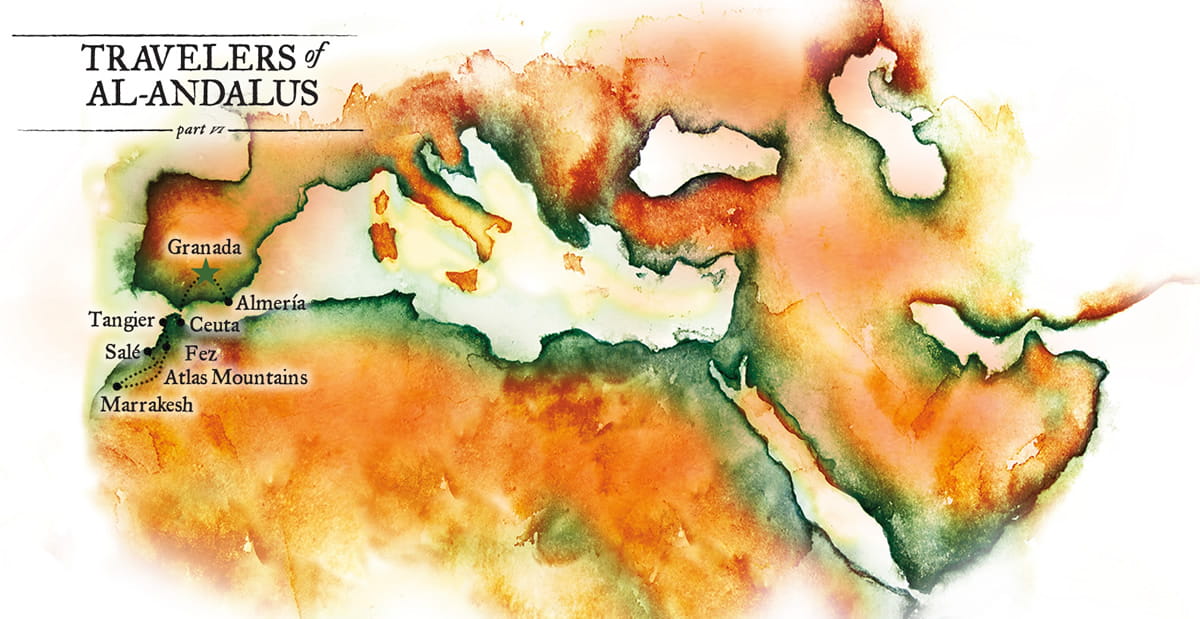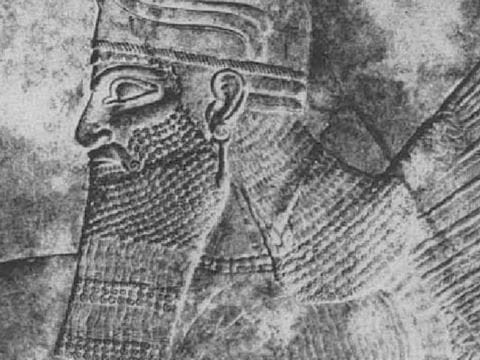
Travelers of Al-Andalus, Part VI: The Double Lives of Ibn al-Khatib
Minister in the Nasrid court of Granada both before and after exile in Morocco, Ibn al-Khatib was a poet, a polymath and an insomniac whose writings earned him renown and a prominent inscription on a wall at the Alhambra.

For Muhammad ibn Abdallah al-Salmani, born in the town of Loja near Granada in the year 1313, travel abroad meant more than mere exile. An accomplished poet and minister in the Nasrid court of Granada during its heyday, when the Alhambra palace was getting its most brilliant finishing touches, he and his sovereign, King Muhammad v, were obligated to flee for their lives to Morocco, to the safety of the court of the Merinid Sultan, when the king’s half-brother launched a palace coup in the year 1359.
And it was in Morocco, based in the seaside town of Salé but often camped outdoors in the wilds of the mountainous interior, that this most erudite and refined man—author of more than 60 works ranging from political theory, veterinary medicine and history to mysticism, administrative science and collections of his prodigious correspondence (which included a letter sent to none other than the Arab world’s most famous traveler of all time, Ibn Battuta, by then long retired from his own journeys around the world)—began also to write travelogues.
Three of them are most playfully entitled: Mi’yar al-ikhtiyar fi ahwal al-ma’ahid wa al-diyar (The Measurement of Choice in the Conditions of Places and Buildings); Khatrat al-tayf fi rihla al-shita wa al-sayf (The Appearance of a Ghost During a Trip of Winter and Summer); and Nufadat al jirab fi ‘ulalat al-ightirab (The Shaking of the Bag for Entertainment While Abroad).
His contemporary polymath and friend Ibn Khaldun said he “possessed an unequal linguistic habit and his pupils followed in his footsteps.” What Ibn Khaldun did not say was that his pupil and equally brilliant poet Ibn Zamrak was the source of his friend’s eventual undoing. Spanish Arabist Emilio García Gomez called him the last great man of letters in Al-Andalus because “after having thrown away the key, he turned out the lights and left it in the dark.”
Those who doubt the excellence of his poetic voice need only read his verses, some in gilded letters on a lapis background inscribed in stucco on the walls of
the Alhambra.
See with your own eyes the delight in me,
And admire my shape and adornments …
Let God who is without form or space give shape
To my creator’s most remote desire.
Known to history under the delightful name Lisan al-Din Ibn al-Khatib (Tongue of Religion, Son of the Sermon-Giver) or, more simply, Ibn al-Khatib, he also accrued three other more telling nicknames. During his lifetime he was known as Dhu al-wizaratayn (He of the Two Ministries), because after three years in exile, he was able to return to Granada, when Muhammad v reclaimed the throne, and resume office.
After his death in 1375, which occurred during his second Moroccan exile and in the shadow of yet further intrigue, his biographer, al-Maqqari, renamed him with the dual monikers Dhu al-‘Amrayn and Dhu al-Mayyitayn (He of the Two Lives and He of the Two Deaths). These were references to the fact that Ibn al-Khatib’s prolific writing was due in part to insomnia: Working by day and night, he accrued the equivalent of two lifetimes; his death, indeed, was by a kind of double execution— strangulation followed by immolation.
Of his travelogues, The Appearance of a Ghost is the more straightforward. It recounts a 21-day journey in the spring of 1347 from Granada to Almería in the company of his Nasrid sovereign Yusuf i, father of Muhammad v, to inspect the kingdom’s defensive perimeter.
Ibn al-Khatib seemingly does the impossible by turning a dry trip report into a literary tour de force of rhymed and rhythmic prose, touching on the descriptions of towns large and small, many of whose names come from the Arabic—Guadix (wadi, or “valley”), Gor (ghor, or “declivity”), Almazora (mahsour, or “restricted”), Almanzora (mansour, or “victorious”) and Purchena (burj, or “tower”)—before arriving at his destination, “a city that guards the independence of the realm, a flourishing city where caravans and fleets keep their rendezvous, a town that hoists its flag of pristine honor and shows itself to be first among its rivals.”
The Legado Andalusí Foundation in Granada has created a tourist map, called Ruta de Ibn al-Jatib (Spanish scholars transliterate “kh” as “j”), which tracks this exact itinerary, with stops along the way to see a mudéjar wooden inlaid ceiling in a former mosque in the town of Baza and the Moorish castle in Lorca. The narrative has been translated into Spanish by Jacinto Bosch Vilá and Wilhelm Hoernerbach.
The Measurement of Choice was written as a maqama, a short-barrel, scattershot literary form invented by the Arabs that aimed to impress readers with impossible-to-match rhetorical extravagances. In his, Ibn al-Khatib wrote of 34 cities in Al-Andalus, including Malaga, Granada and Ronda, which he compared to the Moroccan towns Tangier, Meknes, Ceuta and Fez that he had more recently visited as an exile. Despite being far away, he fondly recalled his childhood home of Loja and its women “who cure broken hearts and rabbits that seem awake while sleeping.”

On the other hand, The Shaking of the Bag—a miscellany of praise poems, history and geography, and personal narrative based on his trips from the High Atlas back finally to Al-Andalus—is far less straightforward. Its vocabulary has been studied for covert meanings, of the inside story within the outside story of a physical journey.
“I am nothing but a wanderer of the road,” he wrote, “who has fled this world as a lion, to isolate myself from it, just as I separate body from soul…. Abstinence from all that men desire brings me wisdom and money to give as alms to others.” Simple travelogue it is not, but rather a kind of secret diary of a man-in-exile’s attempt to save himself from the political storms back home and those he felt were sure to come again.
One might find it strange that Ibn al-Khatib chose his place of exile in Salé rather than the more sumptuous Merinid capital of Fez, calling it “a sandy ground, with water of poor quality … with mosquitoes … its people avaricious and of low intelligence.” But historians speculate that at this point in his life he was set on establishing his own identity, to avoid being too closely associated with a deposed king whose time and fortune he feared were now finished.

These thoughts play out most evidently when he goes up the High Atlas to meet the shaykh of the Hintata tribe, Amir Ibn Muhammad ibn Ali. In the person of the amir, Ibn al-Khatib was eager to find a patron unrelated to and in fact more powerful than the ruling Merinid dynast, because a royal protector he knew could be as easily deposed as was his own patron, Muhammad v.
Indeed, the greatest Merinid sultan of all, Abul Hassan Ali ibn Othman, had expanded his territory across the Algerian coast as far as Tunis, commanding at one point some 40,000 Zinata Berber cavalrymen and troops of Andalusi Arab footmen, and then, following a bad turn in his military campaign, had been dethroned, captured and executed by his son Abu Inan
in 1351.
Ibn al-Khatib calculated that he would need friends in high places whose power was enduring, not fleeting, and thus he looked beyond political dynasties toward the Atlas tribe that had once loyally sheltered Abul Hassan. For a man fluent in the recondite language of diplomacy, to approach and praise such rough-hewn mountain men meant that Ibn al-Khatib felt deeply pressed to seek far and wide a fail-safe insurance policy offering both haven and protector in the event he once again must flee for his life.
Outside Marrakesh in the direction of the Hintata territory, near North Africa’s highest summit, Jebel Toubkal, lies Aghmat, the first capital of the Souss region. It had fallen into such decline—“a place as ugly as it tried to be beautiful,” he wrote—that it had become a miserable place of exile for many former rulers of the petty kingdoms of Al-Andalus, the so-called Taifa states, broken away from the Caliphate in Córdoba.
Two of these were also men of high literary talent, the poet and last Abbadid king of Seville, Al-Mu’tamid ibn Abbad, and the last Zirid king of Granada, Abdallah ibn Buluggin, who wrote his memoirs there. In visiting Aghmat in the footsteps of his fellow Moors, Ibn al-Khatib must have been making a literary pilgrimage as much as he was reconnoitering a safe haven.
We propelled ourselves to climb the crowning mountain like a rapacious bird hanging over our ascent, flanked by the tribal lands of the Hintata, they who are supporters of the state, intimates of the Merinid dynasty, sworn to its obedience, noted for their loyalty, ready to risk their life before they would profane it, to keep a promise and a friendship, deserving above others all prestige. This was the chief incentive for my route, the most simple reason for my trip.
Ibn al-Khatib relates how he sought to make the Merinid amir’s acquaintance, concluding with a 12-line qasida addressed directly to him whose lines include “By God, how you maintain happiness! / By God, what lucky fortune keeps you safe!” The central part of the narrative is not the difficulty of the steep ascent but rather the luxury of its banquet at the summit: “Barely were we seated, relieved of our shoes, when a meal was served that drowned the very sea and flooded its very waves.”
The Shaking of the Bag recounts the return of Ibn al-Khatib to Granada following the reinstatement of Muhammad v to the Nasrid throne, before finally concluding with the account of a ceremony at the Alhambra, the Prophet’s moulid, or birthday celebration, on December 30, 1362. He describes the guest list, menu, palace décor and the king’s attire. “The sovereign’s visage dazzled the eyes,” he wrote, “and what pleased him most was that instead of a crown, he wore a special turban which as of that night became the royal-most symbol of Al-Andalus.
“Scribes, travelers and officials jaded by other such festivals all recognized that this convocation, as much for its location as for its cuisine, music and chronometer [a timekeeping device for measuring the night hours that had been demonstrated], was an event without precedent, that never would be outdone or even repeated.”
A poem by Ibn al-Khatib inscribed in the Court of Myrtles captures the night’s magical setting:
With my jewels and with my crown I surpass the most beautiful,
And before me the stars of the zodiac all bow down ...
It is as though I had received the gift of that bounty which
Flows from the hand of my lord Abu al-Hajjaj[Yusuf i, his former patron]
Thus out of his shaken bag poured many jewels and stars. In his travelogues, Ibn al-Khatib always wrote about more than simple arrivals and departures and the stopping places in between. He wrote in the highest form of Arabic literary prose, and signed his name upon the Alhambra itself. The millions of tourists from all over the world who visit the palace each year see his verses adorning its walls in praise, even if few can now read them.
“Travelers of Al-Andalus” is a six-part series selected and adapted from the original 41-part series “El Viajero Histórico,” an idea and production by Ana Carreño Leyva in El Legado Andalusí: Una Nueva Sociedad Mediterránea, the magazine of the Andalusian public foundation El Legado Andalusí, based in Granada, Spain, from 1990 through 2010. Adapted from the original by Hamid Triki, which appeared in issue number 11, titled “Ibn Al-Jatib: El hombre y sus dobles.”
You may also be interested in...

Stratford to Jordan: Shakespeare’s Echoes of the Arab World
Arts
History
Shakespeare’s works are woven into the cultural fabric of the Arab world, but so, too, were his plays shaped in part by Islamic storytelling traditions and political realities of his day.
AramcoWorld: Celebrating 75 Years of Global Historical Insight
History
Cover stories that bridge the past and present offer insights into humanity’s common ground. From archeology to historical objects, people, places and more we share connections to one another.
Spotlight on Photography: Discover the Marshes of Iraq in a Visual Story by Wilfred Thesiger
Arts
History
“In the Marshes of Iraq” — November/December 1966